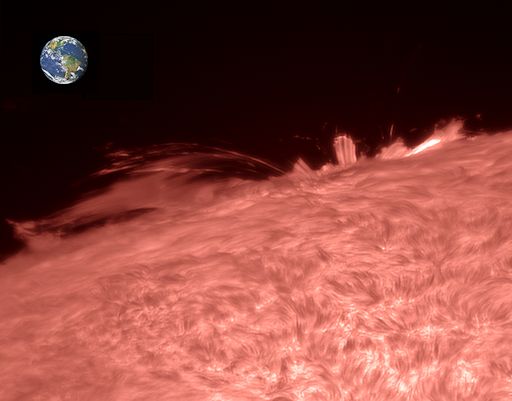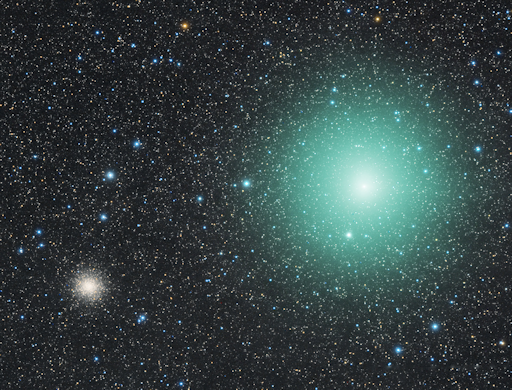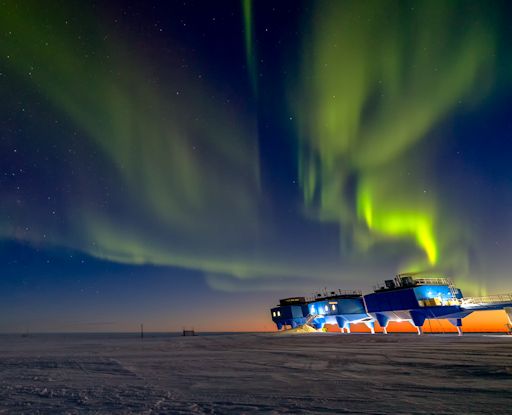Marianne's Heaven On Earth Aurora Chaser Tours Chasethelighttours.co.uk invites you to join them in their quest to find and photograph the Aurora Borealis. Experience the winter wonderland in the Tromsø Area. | | |
SPACE WEATHER ON FACEBOOK: Are you on Facebook? Good news: So is Spaceweather.com! If you would like to see our daily content in your Facebook feed, just click here and follow us.
GEOMAGNETIC STORM IN PROGRESS: Earth has just crossed a fold in the heliospheric current sheet, plunging our planet into a region of space filled with "negative-polarity" magnetic fields. This has triggered a G1-class geomagnetic storm, in progress. Arctic sky watchers should be alert for auroras on April 7-8. Aurora alerts: text or voice
A SUNSPOT IN THE OFFING: Solar astronomers are monitoring the eastern limb of the sun, where plumes of plasma and flashes of electromagnetic radiation are heralding the approach of a new sunspot. Philippe Tosi of Nîmes, France, photographed the maelstrom from his backyard observatory on April 7th:

"I witnessed a violent eruption when I looked through my solar telescope," says Tosi, who inserted a picture of Earth for scale.
NASA's Solar Dynamics Observatory is seeing the edge of a sunspot emerging from the tempest: photo. Is it a big one? We will find out soon as the sun turns the active region more squarely toward Earth. Stay tuned for a better view. Solar flare alerts: text or voice
Realtime Space Weather Photo Gallery
COMET VS. STAR CLUSTER: Comet 252P/LINEAR, which made a historic close approach to Earth last month in southern skies, has crossed the celestial equator. Now, the receding green comet is visible to northern observers. In Mayhill, New Mexico, on April 6th, Adriano Valvasori photographed it passing by star cluster M14 in the constellation Ophiuchus:

"To take this picture, I used a 4-inch refracting telescope and an SBIG digital camera," says Valvasori. "It is a 180s exposure."
If the comet looks big, that's because it is. The comet's atmosphere is more than 90,000 km in diameter, more than half the size of the planet Jupiter, and about twice as wide as Neptune. It's green because its vaporizing nucleus emits diatomic carbon, C2, a gas which glows green in the near-vacuum of space.
The star cluster, on the other hand, has a golden hue, the color of old stars. Lying some 30,000 light years from Earth, M14 contains some of the oldest stars in the galaxy. Astronomers say the swarm formed more than 10 billion years ago.
Comet 252P/LINEAR is slowly passing M14 as it heads farther into northern skies. The green fuzzball is barely visible to the naked eye, but as Valvasori's photo shows, it is a magnificent site in small telescopes. Observing tips are available from Sky and Telescope.
Realtime Comet Photo Gallery
[More about 252P: brightness measurements, 3D orbit, orbital elements]
ANTARCTIC LIGHTS: When the sun goes down over Halley Research Station in Antarctica, the darkening sky usually turns an icy shade of sunset red. On April 2nd, the primary color was, instead, green:

"The auroras were incredibly fast moving and at times covered with entire sky," says photographer Greig Lawson, the station's doctor, who ventured out onto the ice during a G2-class geomagnetic storm. "They were clearly visible even while the sun was still setting."
Operated by the British Antarctic Survey, the Halley Research Station is known for its studies of ozone, cosmic rays, and climate change. It is located on the Brunt Ice Shelf, a 130 meter thick slab of frozen water that floats atop the Weddell Sea. Such a platform is a dangerous place to be. Pieces of the shelf frequently break off, or "calve," giving birth to new icebergs. The current base structure, Halley VI, can avoid unstable ice by relocating itself. The station's colorful modules are built upon huge hydraulic skis.
Lawson will be busy in the months ahead tending to the station's wintertime staff of 16. Hopefully, he'll have time send more pictures. As the Arctic brightens, making Northern Lights difficult to see, the Antarctic will darken, providing a velvety canvas for geomagnetic storms to paint their colors on southern skies.
Realtime Aurora Photo Gallery
Solar Eclipse Photo Gallery
Every night, a network of
NASA all-sky cameras scans the skies above the United States for meteoritic fireballs. Automated software maintained by NASA's Meteoroid Environment Office calculates their orbits, velocity, penetration depth in Earth's atmosphere and many other characteristics. Daily results are presented here on Spaceweather.com.
On Apr. 7, 2016, the network reported 48 fireballs.
(48 sporadics)

In this diagram of the inner solar system, all of the fireball orbits intersect at a single point--Earth. The orbits are color-coded by velocity, from slow (red) to fast (blue). [Larger image] [movies]
Potentially Hazardous Asteroids (
PHAs) are space rocks larger than approximately 100m that can come closer to Earth than 0.05 AU. None of the known PHAs is on a collision course with our planet, although astronomers are finding
new ones all the time.
On April 7, 2016 there were potentially hazardous asteroids.
 |
Notes: LD means "Lunar Distance." 1 LD = 384,401 km, the distance between Earth and the Moon. 1 LD also equals 0.00256 AU. MAG is the visual magnitude of the asteroid on the date of closest approach. | | Cosmic Rays in the Atmosphere |
| Situation Report -- Oct. 30, 2015 | Stratospheric Radiation (+37o N) |
| Cosmic ray levels are elevated (+6.1% above the Space Age median). The trend is flat. Cosmic ray levels have increased +0% in the past month. |
| Sept. 06: 4.14 uSv/hr (414 uRad/hr) |
| Sept. 12: 4.09 uSv/hr (409 uRad/hr) |
| Sept. 23: 4.12 uSv/hr (412 uRad/hr) |
| Sept. 25: 4.16 uSv/hr (416 uRad/hr) |
| Sept. 27: 4.13 uSv/hr (413 uRad/hr) |
| Oct. 11: 4.02 uSv/hr (402 uRad/hr) |
| Oct. 22: 4.11 uSv/hr (411 uRad/hr) |
These measurements are based on regular space weather balloon flights: learn more. Approximately once a week, Spaceweather.com and the students of Earth to Sky Calculus fly "space weather balloons" to the stratosphere over California. These balloons are equipped with radiation sensors that detect cosmic rays, a surprisingly "down to Earth" form of space weather. Cosmic rays can seed clouds, trigger lightning, and penetrate commercial airplanes. Our measurements show that someone flying back and forth across the continental USA, just once, can absorb as much ionizing radiation as 2 to 5 dental X-rays. For example, here is the data from a flight on Oct. 22, 2015:

Radiation levels peak at the entrance to the stratosphere in a broad region called the "Pfotzer Maximum." This peak is named after physicist George Pfotzer who discovered it using balloons and Geiger tubes in the 1930s. Radiation levels there are more than 80x sea level.
Note that the bottom of the Pfotzer Maximim is near 55,000 ft. This means that some high-flying aircraft are not far from the zone of maximum radiation. Indeed, according to the Oct 22th measurements, a plane flying at 45,000 feet is exposed to 2.79 uSv/hr. At that rate, a passenger would absorb about one dental X-ray's worth of radiation in about 5 hours.
The radiation sensors onboard our helium balloons detect X-rays and gamma-rays in the energy range 10 keV to 20 MeV. These energies span the range of medical X-ray machines and airport security scanners.
| | The official U.S. government space weather bureau |
| | The first place to look for information about sundogs, pillars, rainbows and related phenomena. |
| | Researchers call it a "Hubble for the sun." SDO is the most advanced solar observatory ever. |
| | 3D views of the sun from NASA's Solar and Terrestrial Relations Observatory |
| | Realtime and archival images of the Sun from SOHO. |
| | from the NOAA Space Environment Center |
| | the underlying science of space weather |

